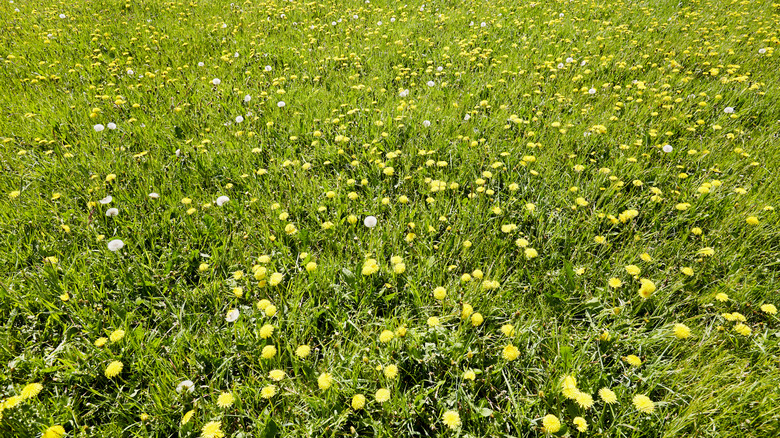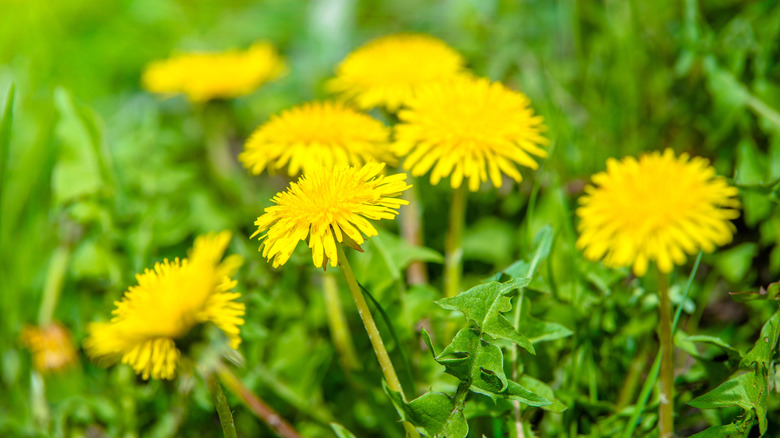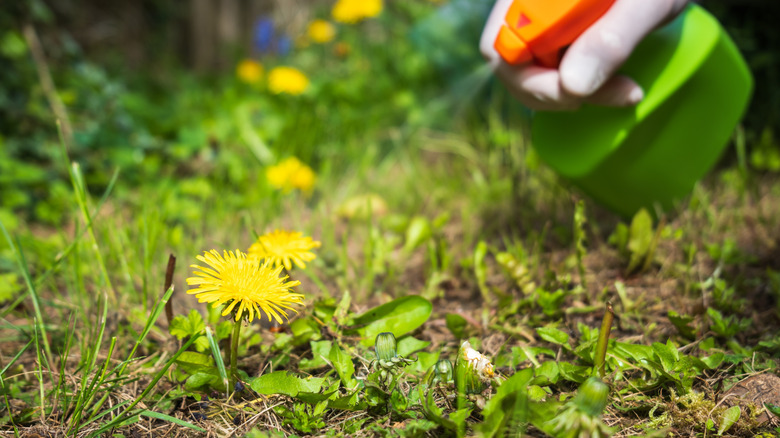How To Stop Dandelions From Taking Over Your Yard Or Garden
We may receive a commission on purchases made from links.
Dandelions are one of the most recognizable weeds out there. They're not always considered as bothersome as other weeds, thanks to their pretty yellow flowers and charming seed heads. While there are benefits to having dandelions in your lawn, the main downside is that they're prolific enough to outcompete your grass — and the more they take over, the harder they are to get rid of. A two-pronged preventive approach is best: first, dandelion-proof your lawn by keeping it healthy and strong, and second, remove individual dandelions as needed.
Dandelions are difficult to remove for a few reasons. A flower in the daisy family, dandelions have deep tap roots that can generate entire new plants even if the flowering part of the dandelion is removed. Their signature seed heads, often used to make wishes, can spread more than 20,000 seeds that easily blow in the wind. And as perennials, dandelions come back every year.
Dandelions aren't all bad for lawn owners. They provide food for pollinators, and all parts of the plant are edible. The leaves can be eaten raw or cooked, the flowers can be used for wine, and the roots can be used for tea. They also have homeopathic medicinal uses. However, as an uninvited guest in your lawn, dandelions take resources meant for your grass and may be unsightly. Thankfully, the best defense against dandelions is a good offense, and you may be doing some of it already.
How to prevent dandelions
The most effective method for getting rid of pesky dandelions is to maintain your lawn's health. A strong lawn is less vulnerable to weeds, as the grass grows thicker and doesn't leave as many opportunities for weeds to thrive. This means consistently watering your lawn and fertilizing two to four times per year with a nitrogen-rich fertilizer. Additionally, it's best not to mow the grass too short, because taller blades are better able to shade out weeds. The proper height depends on the type of grass. For example, Kentucky bluegrass and tall fescue should be mowed taller in comparison to fine fescues or perennial ryegrass. When you mow, leave the grass clippings on the lawn to further block weeds from sprouting.
In the meantime, pull dandelions by hand to cut down on the issue. The entire taproot needs to be removed to prevent the plant from growing back, and this can be difficult to do by hand. Thankfully, there are special dandelion weeder tools that make removal easier (and allow you to weed without bending over). You can also cut down on effort by weeding while the soil is moist after rain or watering. This process must be done regularly in order to keep dandelions at bay long-term. Try to remove dandelions while they're still young and have smaller taproots, and always pull them before they form a seed head. Otherwise, you will soon have many more dandelions to tackle.
A last resort option
If the process above isn't entirely effective or dandelions have already begun a lawn takeover, herbicides are also an option. There are two categories of herbicides to consider: Natural remedies and synthetic formulas. Both types should be used selectively and with caution as they can also kill other plant life in the area.
Plant-based products that kill dandelions include cinnamon oil, clove oil, and citric acid-based products. Another option is horticultural vinegar. Horticultural vinegar is much higher in acetic acid than regular household vinegar and can be purchased online or at home improvement stores. All of these herbicides are non-selective, so they will kill any plant they touch, not just dandelions.
As for synthetic herbicides, look for products that contain triclopyr, dicamba, MCPP, MCPA, or 2,4-D. These are broadleaf herbicides that will kill the entire dandelion, including that pesky taproot, without killing the grass. Products with two or three of these herbicides will also kill other broadleaf weeds. The best time to treat your lawn for dandelions is in the fall, when the plants send nutrients (and herbicides) down to their roots for the winter. Although they don't harm grass, synthetic herbicides may damage shrubs, trees, vegetables, or other nearby plants. Only use them when needed, spray the affected areas rather than the whole lawn, and avoid spraying on windy days.


